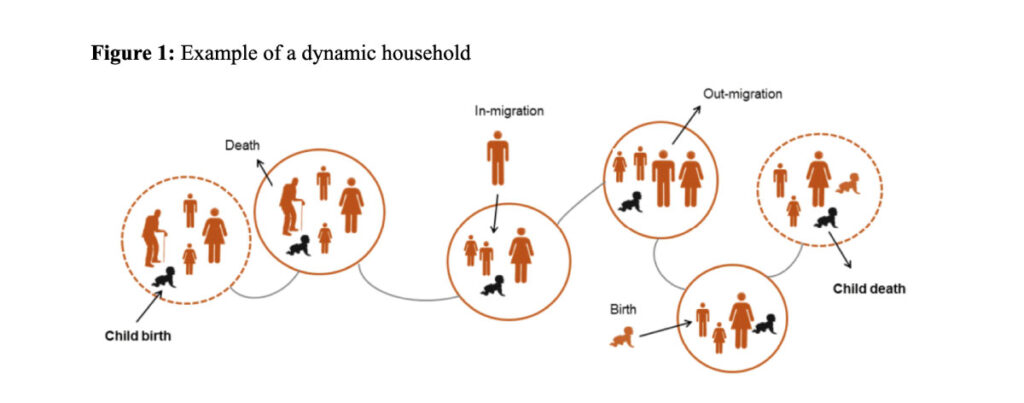Shifting households and their effect on child mortality in sub-Saharan Africa

Households are important units of social, psychological and economic support for children, and variation in the presence of household members at different times can determine child survival. Ashira Menashe-Oren, Yacouba Compaoré, Philippe Bocquier, Carren Ginsburg find considerable churning of households in sub-Saharan Africa, with those including older adults being associated with higher under-five mortality, though this differs by kin relationship.
Household structure and composition reflect the individual life trajectories of household members, who are often linked by family ties. Individuals may be born, or die, move in or out, and together they shape the living environment of young children. Children are dependent on household members for essential care, including economic support and socialisation. While this is often given by parents, other household members can also contribute to children’s wellbeing and survival.
Household dynamics: a longitudinal perspective
Fluidity in households and their membership make it difficult to capture these features in quantitative analysis. Households can be defined as a status (sharing a homestead), or as a network through which support is transferred. Moreover, individuals are generally considered as members of only one household unit, though this is not always the case. Longitudinal data can help to capture shifting households, although a specific definition of “household” must be applied.
Health and Demographic Surveillance Systems (HDSS) provide an exceptional opportunity to examine these shifts in households in sub-Saharan Africa, because they “follow” populations within a geographically delimited region, recording the demographic events of individuals embedded in households, and making it possible to identify a household’s structure and composition at the time of any event (in contrast to only at the time of survey data collection).
Using de facto household membership (people living in the same residence), it is possible to follow the movements of individuals in and out of households, and to know household structure and composition at any given time (Menashe-Oren, Compaoré, et al. 2023). Figure 1 illustrates how a child may experience multiple changes in a household before reaching age five and highlights that the same structure (number of members) may correspond to different compositions (kin relationships).
In the rest of this article, we will consider the household structure and composition at the time of a child’s death.

The role of the household in child mortality
Child mortality remains high in sub-Saharan Africa as compared to other regions of the world: according to the UN World Population Prospects, the under-five mortality rate was 70.1 per 1,000 in 2022, whereas the second highest rate was 36.0 in Central and Southern Asia, and the lowest rate 3.5 in Australia and New Zealand. That said, important gains have been made in reducing child mortality in sub-Saharan Africa, thanks to multiple factors including improved infrastructure, better access to medical services and an increase in maternal education.
Children’s survival can also be determined by the close social environment in which they live: the household. It is well established that the presence of a mother has a positive effect on child survival, while for fathers the evidence is varied (Sear and Coall 2011). Similarly, grandparental involvement, and particularly co-residence with a child can be important.
Recent evidence using HDSS data from multiple sites in five countries in south-eastern sub-Saharan Africa (Ethiopia, Kenya, Mozambique, Tanzania, South Africa), displayed in Figure 2, indicates that for children aged under five, the presence of an older adult (65+ years old) in the household increases the likelihood of death by 23% in comparison to children in nuclear-type households (Menashe-Oren, Bocquier, et al. 2023). Rather than helping with care, older adults likely require care themselves, and resources need to be spread more thinly than in smaller nuclear-type households. However, this HDSS-based study was limited to examining household structure, without consideration for kin relations.

In other work, also using HDSS data from three West African countries (Burkina Faso, Senegal and The Gambia), where relationships between individuals were taken into account, it was found that the association between an older adult in the household and child mortality depends on the older adult’s relationship to the child. In the case of a co-resident paternal grandfather, the risk of a child’s death is 25% higher, but with a co-resident maternal grandmother, the child’s survival chances increase by 50% compared to children not living with grandparents (Compaoré 2021). With the decline in adult mortality, the proportion of children living with grandparents (in three-generational households) has been increasing in many African countries since the 1990s, so this is a particularly important point to consider.
References
Compaoré, Y. Dynamiques familiales et santé des enfants: perspectives longitudinales en Afrique de l’Ouest. UCL-Université Catholique de Louvain
Menashe-Oren, A., Bocquier, P., Ginsburg, C., Compaoré, Y., & Collinson, M. A. (2023). The dynamic role of household structure on under-5 mortality in southern and eastern sub-Saharan Africa. Demographic Research, 49 (Article 11), 249–294. https://doi.org/10.4054/DemRes.2023.49.11
Menashe-Oren, A., Compaoré, Y., Bocquier, P., & Ginsburg, C. (2023). Dynamic household structure and composition: a manual for longitudinal analysis of living arrangements. BMC Research Notes, 16(223), 1–6. https://doi.org/10.1186/s13104-023-06485-x
Sear, R., & Coall, D. (2011). How Much Does Family Matter? Cooperative Breeding and the Demographic Transition. Population and Development Review, 37 (SUPPL. 1), 81–112. https://doi.org/10.1111/j.1728-4457.2011.00379.x